Delving into the world of options trading is not just intriguing, it’s downright enlightening. It’s like peeling back the layers of a financial onion to discover the myriad ways traders employ options to gain that crucial edge in the market. You see, at its core, options are all about risk management. That’s right, these financial instruments are the secret weapons sophisticated traders use to meticulously handle risk with each and every trade they make.
But here’s the kicker: Options, despite their immense power, often remain shrouded in mystery for many in the trading game. It’s like having a high-performance sports car but not knowing how to shift gears properly. In this article, we’re going to do some demystifying. We’re going to break down the crucial aspects of options trading, giving you a comprehensive view and understanding of these formidable risk management tools. So, fasten your seatbelts, because we’re about to take a deep dive into the world of options like never before. In this dynamic arena, options provide a unique landscape that allows you to thrive in all types of markets. It’s like having a versatile toolkit at your disposal, enabling you to adapt to various market conditions. Learning the difference between buying and selling calls and puts is your gateway to harnessing the odds of success in your favor. So, let’s dive in and explore how these strategies can empower you to navigate the markets with confidence, regardless of which way the wind is blowing.
In the world of finance, an option is a contract that bestows upon its buyer the remarkable right, albeit not the obligation, to either buy or sell an underlying asset. All this is to be done at or before a pre-determined price, and it must occur before a specific expiration date, all in exchange for a premium payment.
Now, when you’re the buyer of an option, you’re essentially securing yourself some insurance on that price. It’s like a financial safety net. You’ve got the right to act, but you don’t have to.
But let’s not forget about the other side of the equation . The creator of that option, that’s the seller, they’re not just casually conjuring up a contract; they’re forging a bona fide commitment between themselves and the option’s buyer. It’s a pledge to either hand over the asset or accept delivery of it, and this exchange occurs at a pre-arranged price. This is an obligation which is enforced by the exchange and broker.
Now, for a full grasp of options, let’s dive into the four potential initial options trades you can engage in:
1. **BUYING a Call Option:** Here, your risk is confined, neatly wrapped up in the premium you’ve paid. But your return? Well, that’s a tantalizing prospect of boundless unlimited potential. As a call option buyer, you have the right but not the obligation to buy the underlying asset at a predetermined price, between now and an expiration date in exchange for a premium payment.
2. **Buying a Put Option:** Again, your risk is capped at the premium you’ve doled out. But the return, while not boundless like the call option, does have a limit. It’s tethered to the stock price, and if that stock sinks to zero, well, there is your return. As the buyer of a put option you have the right but not the obligation to SELL the asset at a predetermined price, at or before an expiration date in exchange for a premium payment.
3. **Selling (WRITING) a Call Option:** Now, this one’s different. Theoretically, your risk knows no bounds and is potentially unlimited… But your potential return? It’s neatly confined to the premium you pocketed. As a call options seller your maximum return is the premium you receive for creating the options contract. As a seller of a call option contract, you are obligating yourself to SELL the underlying asset at a predetermined price, in EXCHANGE for the premium you receive.
4. **Selling (WRITING) a Put Option:** Here, your risk is cushioned, limited to the stock’s price. If that stock decides to plummet to zero, you’re on the hook to deliver the asset at your agreed upon price. Your potential return? It’s snugly tied to the premium you cashed in. Selling put options carries the potential for limited profit through the premium received upfront. However, it involves the risk of substantial losses if the underlying asset’s price significantly declines below the strike price, as the seller may be obligated to buy the asset at a higher price than its current market value.
So, in the grand ballet of options, it’s all about understanding these intricate realities, these nuanced risks, and rewards. It’s a financial waltz that demands precision and strategy. After all, in the realm of options, knowledge is power, and careful choreography can make all the difference.
What makes an option tick? It all boils down to understanding the difference between a “right” and an “obligation.” You see, when you buy an option, you’re holding a “right” in your hand. In simple terms, it means you’re shelling out a premium to the option’s creator for the privilege of having the “right” to buy or sell an asset at a specific price, all the way from today until a certain expiration date. This is fundamental, and it’s the essence of all options. Options are like those contracts in the derivative world, and they’re only valid for a set period. The buyer, well, they’re not chained by obligation; they’ve got a “right.”
Let me break it down even further, just like you’re looking at your insurance policy. Now, think of your insurance policy as an options contract. You, as the savvy policyholder, have a “right” to a certain level of protection that’s on the table from now until a specific expiration date. But here’s the kicker, you’re paying the insurance company a premium for dishing out that coverage. Just like that, your insurance policy has a due date, and once that date rolls around, you’re out of luck unless you renew the policy and hand over another premium.
The following graphic illustrates the difference between an OPTION BUYER and OPTION SELLER and the desired outcome they are looking for.
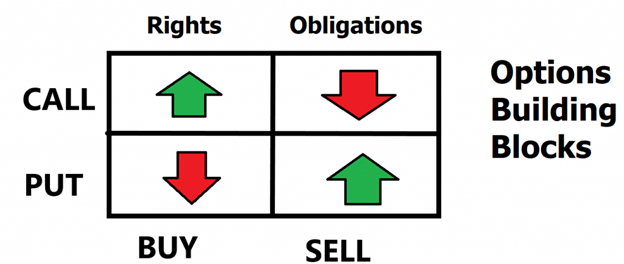
The reason why options trading is misunderstood by most traders and investors is that they STAY on the left-hand side of the above graphic at all times because they are lured in by the sweet soothing sounds of LIMITED RISK . Don’t get me wrong, there are times when LIMITED RISK is exactly where you want to be. But there are times when LIMITED RISK is completely counterproductive to being profitable. This does not mean you should take unlimited risk and comprehending these nuances is what makes the options world exciting and potentially very profitable.
Your goal in options education and trading is to learn how to mix and match options together to create scenarios where you create a very clear and precise mathematical edge for yourself. You will only be able to accomplish this objective when you explore the right-hand side of the graphic that forces you to understand the obligations that an options seller creates.
Let me explain.
I want you to imagine you are walking into a casino. Every game in that casino is there for one reason only. That is to extract money from you, the casino patron. I would go so far as to state that the entire city of Las Vegas was built because the casinos worship at the altar of understanding probability theory. Casino patrons on the other hand are lured in by the possibility of huge rewards with LIMITED RISK.
Take for example, the game of roulette. In a basic roulette game, there are typically 38 slots (1-36, 0, and 00) on the wheel. If you bet on a single number, the odds of winning are 1 in 38, or approximately 2.63%. The house edge is the casino’s advantage, which in American roulette is about 5.26%.
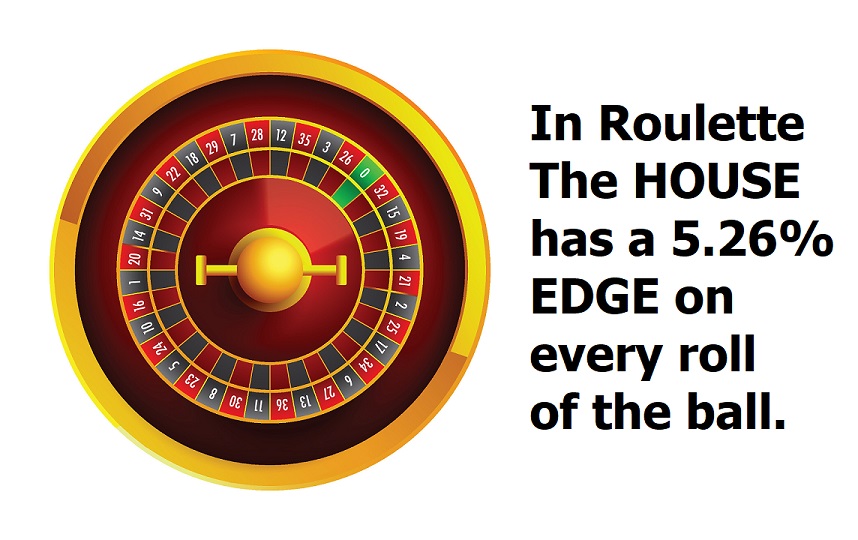
If a roulette patron plans to gamble $500, on average, they can expect to lose around $26.30 due to the house edge.
The only reason I am bringing a roulette wheel into this discussion of options is that you need to understand how the CASINO creates its very predictable edge. It does so, by always having the odds in its favor. If the odds are 38 to 1 of you being correct, but I only pay you based upon 35 to 1 odds, I have crafted a very predictable and reliable edge in the game I am tempting you to play.
This would be similar to a simple coin toss where there are only two outcomes you flip heads or tails. This is an even money activity. But if I pay you 95 cents for every time you win, and you pay $1.00 to play the game, I have created a cash cow for myself as long as I can create a means to make sure that game is played for a very long period of time.
Studying options allows traders to create very precise risk reward scenarios that often have a very high probability of success. By learning how to sell TIME and collect premium instead of simply creating directional trades, a trader can begin to think like a landlord or casino who is collecting rent on a regular basis.
As a simple thought exercise, I want you to imagine being able to walk into any casino, and instead of being the gambler, assume the role of the house. Instead of making the bets, you start taking the bets. This thought exercise is the simplest and most effective way for you to understand the fascinating world of selling options and collecting premium. It certainly has its risks. But it also has its unique advantages and learning how to minimize or eliminate risk is the lesson to be learned when you learn options trading.
Let me explain.
Imagine there are two traders who have differing views of the market. The first trader is very bullish $META and thinks it will rise 30% in the next 2 months. The second trader is neither bullish nor bearish.
An options contract involves several key components: First, it specifies the “quantity of options traded,” which represents the number of option contracts being bought or sold. Next, it designates the “name of the company,” referring to the underlying asset such as a stock or index. The “strike price” is the predetermined price at which the option holder can buy (in the case of a call option) or sell (in the case of a put option) the underlying asset. The “expiration date” sets the deadline by which the option must be exercised, or it becomes invalid. Options belong to a “class,” either calls or puts, which signifies their function. Lastly, the “premium paid” is the upfront cost paid by the option buyer to the option seller, representing the price of the option contract and its potential rights and obligations.
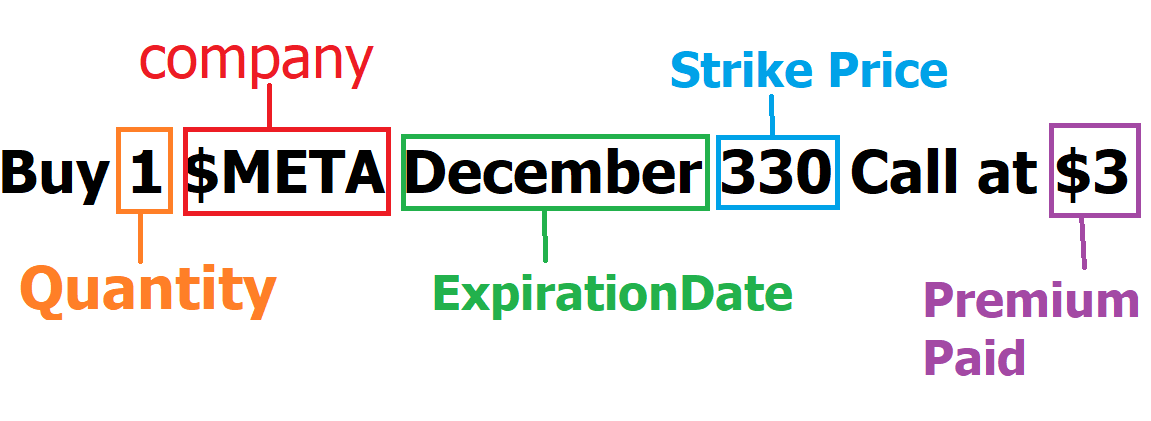
Let’s dig into the above trade so we can understand the context and the perspective of the traders involved.
The BUYER of the CALL Option above loves the idea of having limited risk. Let’s say they are very bullish on $META. They love the idea of only risking $3 premium to be able to purchase 100 shares of $META at $330 between now and the December expiration date. The most they can make is theoretically infinite as $META could in theory be priced at INFINITY. If they are correct, they will make exponential returns. If they are incorrect, they will only lose $3 per share. Every options contract represents 100 shares, so their total risk is $300.
This is how their profit and loss graph looks like:
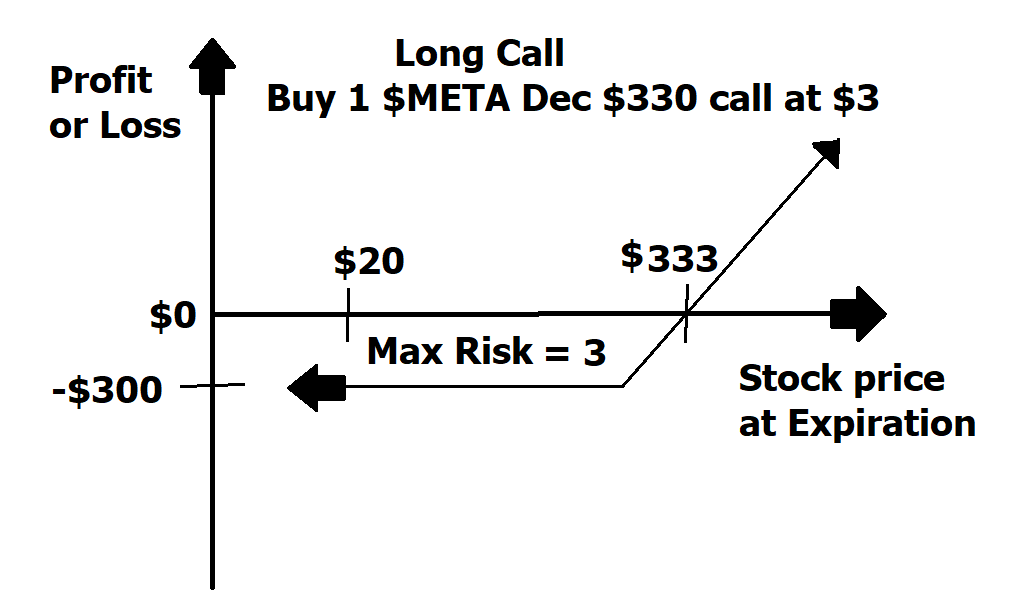
One aspect of options trading that is essential to understand is the breakeven point of the options trade at expiration. To calculate this, we simply need to add the PREMIUM and the strike price together.

So, if the call option buyer in this instance is planning on holding the trade till expiration their break-even price is the $330 strike price plus the $3 premium, or $333.
On the other side of the transaction is the CALL option seller . For purposes of discussion let’s assume they are neither bullish nor bearish. They own $META in their portfolio and plan to continue owning it for a long time. They have learned a little about options trading and they decided that since they own $META at $200, they choose to sell the $330 call and collect the $3 per share premium payment. By selling this call option they have obligated themselves to deliver their $META shares at $330. For that obligation they have received a $3 premium payment today. The obligation they created exists until they either offset the trade or the contract expires on the third week of December. If they are wrong and $META moves lower the $3 premium collected will help offset whatever loss, they incur on their stock ownership. The $3 premium payment could also be viewed in this regard as lowering their cost of acquiring their $META shares.
If $META moves higher and above the $330 strike price they will be obligated to deliver their shares of stock at $330 but keep the premium.
The profit and loss scenario for this option seller is below.
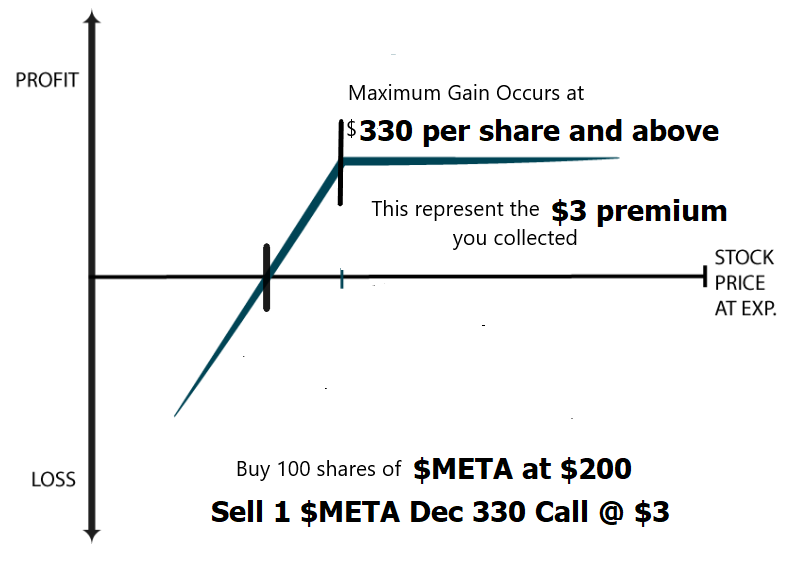
When you study both, the traders clearly define the context, perspective, and strategy. They both have made very different tactical bets. Instead of looking at which is better or worse, understand both perspectives and recognize that both traders have a completely different tolerance for risk and long-term outlook.
Had the second trader not owned the underlying stock of $META this is what their RISK REWARD profile would look like in simply selling the call option and collecting the premium.
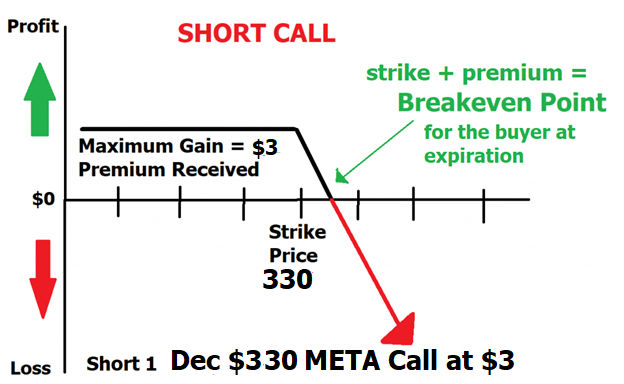
While this can seem overwhelming when you first start studying options it becomes very second nature once you jump into the options trading arena,
An option can be likened to a deteriorating asset due to its finite life cycle. This concept is rooted in the understanding that, assuming all other factors remain constant, the value of an option steadily diminishes over time. As each day passes, the option loses a portion of its potential. This phenomenon is known as “time decay” or “theta decay.” It occurs because the closer an option gets to its expiration date, the less time there is for the underlying asset’s price to move in a favorable direction, making it less likely to be profitable. In essence, the option’s limited lifespan is a built-in mechanism that erodes its value over time, highlighting the importance of timely decision-making and strategic trading in the options market.
Graphically we can illustrate an options time decay as follows: Note how exponentially the decrease is in the last few weeks of an options lifespan.
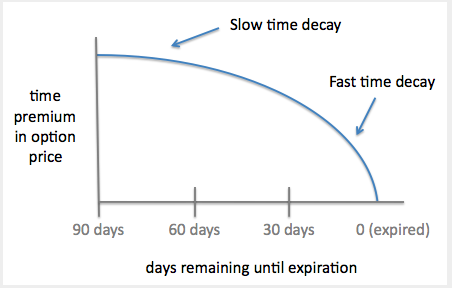
This aspect of options as a deteriorating asset also is what entices traders to study options in greater depth because there are hundreds of strategies and tactics that option traders utilize that involve the selling of option premium. I compare them to understanding the casino creates its edge in the markets.
Let’s now apply the same thought processes to exploring the buying and selling of put options.
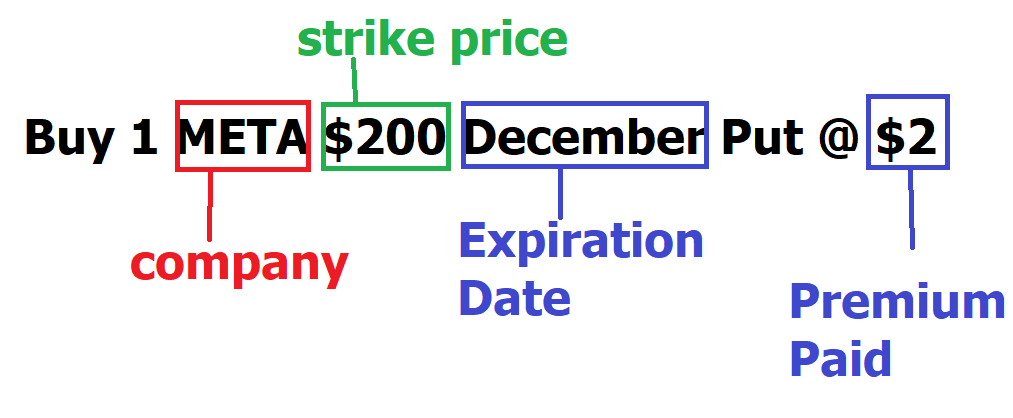
Now, let’s break down these put options in the simplest way possible, folks.
In this example, the buyer’s putting down $2 per share or $200 in total for a rather intriguing privilege. What’s that privilege, you ask? Well, it’s the right to sell $META at $200 any time between now and that December expiration date. Now, here’s the beauty of it: their risk? It’s neatly confined to that premium they shelled out, which is $200. And when’s this contract’s rendezvous with destiny? It’s set for the third week of December.
So, you might be wondering, is this a good deal? Well, hang on to your hats, folks, because it all hinges on where our old friend, the underlying asset $META, is playing in December.
Here’s the scoop: If, come December expiration, $META is strutting its stuff at $200 or higher, that option? Well, it’s going to pack its bags and head for the hills, absolutely worth zilch.
Now, here’s a little nugget of wisdom: The breakeven point for a put option buyer? It’s always going to be the strike price minus that premium they laid down. So, in this case, we’ve got a strike price of $200, and when you subtract the $2 premium, what do you get? $198 per share, my friends. That’s the magic number, the breakeven point.
Now, let’s visualize this whole shebang, shall we?
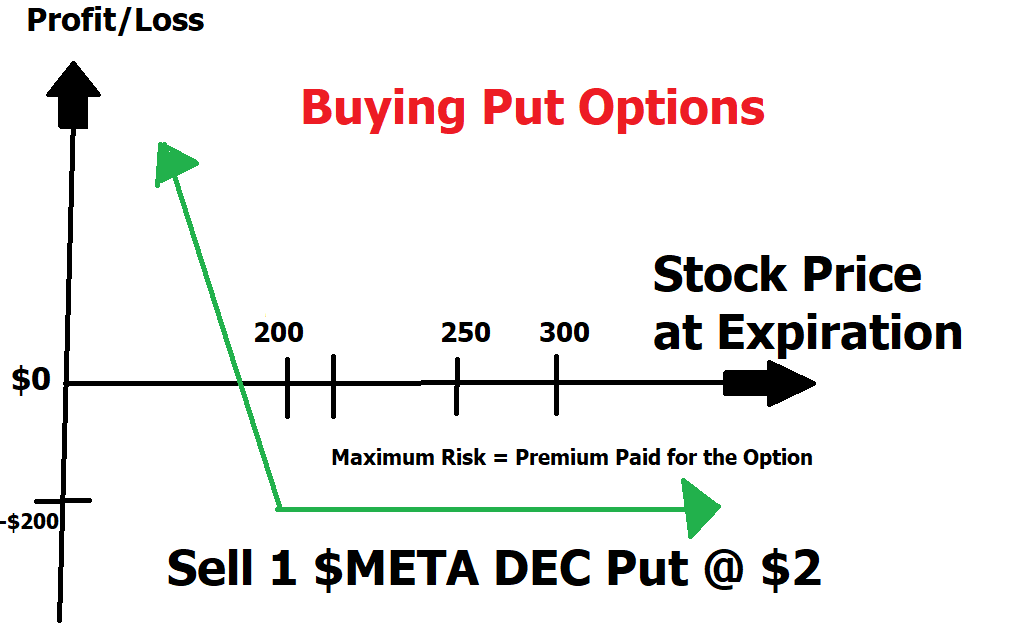
As the graphic above clearly illustrates in the example above, the maximum risk is the premium paid of $2 per share or $200. If the put option buyer were planning to hold the trade till expiration date, they would be profitable at any price below $198 which represents the breakeven point. This is calculated by subtracting the premium paid of $2 from the strike price of $200.
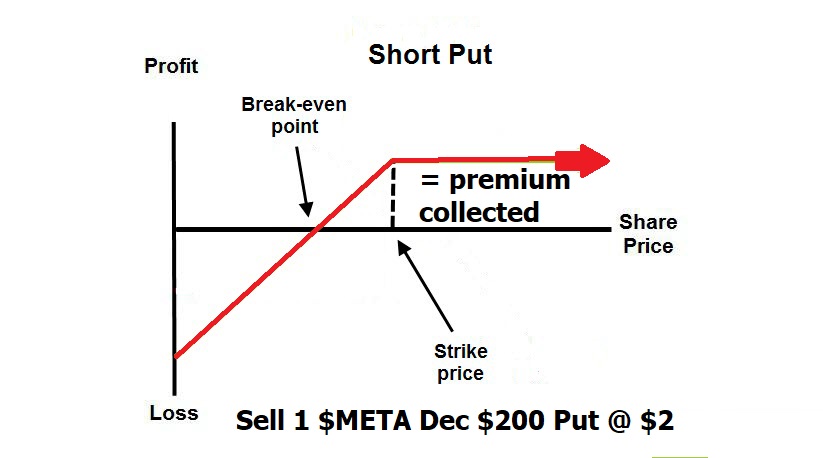
Now, for purposes of discussion and illustration let’s dive into the playbook of one of the greatest investors of our time, none other than Warren Buffett himself. This man’s got a strategy that’s as timeless as it is effective. HE LOVES TO SELL PUT OPTIONS.
You see, Mr. Buffett, he’s the poster child for the long game. As he often quotes in his annual investor letters, his preferred holding time for a stock is FOREVER. He’s all about building up that solid, fundamental value for a company. And here’s where it gets interesting: When a company gets really close to that sweet spot, that fundamental valuation level, Mr. Buffett, through his Berkshire Hathaway fund, well, he starts doing something quite intriguing. He starts selling those long-term puts on that company, and what does that mean? It means he’s obligating himself to buy the underlying shares of the company at a certain price, all while collecting a premium in the meantime.
Now, here’s where the magic happens in Mr. Buffett’s mind: Let’s say that company’s trading at two hundred bucks, and he figures that’s a pretty fair deal. But then, someone comes along, willing to pay him two bucks, obligating him to buy that company at two hundred bucks. What’s that do? Well, it lowers its break-even price to one hundred ninety-eight bucks a share. So, he already liked it at a hundred, but now, at $198, he’s getting his hands on this asset for less than what it’s truly worth, and he’s ready to hold onto it until it becomes a real diamond in the rough. What makes this potential play even more intriguing is going out further on the calendar and collecting even more premium.
Now, let’s talk short-term traders because they’re taking a page from Mr. Buffett’s book, too. They’ve got their eyes on the expiration date of these contracts. You see, options expire all the time, every week, on many stocks. And when the markets on the upswing, they’re selling put options, with a pretty darn high chance of success,
In the world of trading, mastering the four basic options strategies is nothing short of imperative. These strategies offer traders a spectrum of tools, from managing risk with precision to generating consistent and predictable returns. Each strategy is like a different instrument in a musician’s toolkit, and understanding how to wield them effectively is the key to crafting your edge in the markets. Whether it’s the protective shield of buying a put option, the income-generating prowess of selling a covered call, the strategic flexibility of using a long call, or the risk-averse nature of employing a long put, these strategies allow traders to navigate the ever-changing tides of the market with confidence. So, remember this, my friends, options aren’t just financial instruments; they’re your pathway to mastering risk and harnessing the power of market opportunities, offering the potential for both limited risk and consistent, predictable returns. It’s a skill worth honing, and it’s your edge in the ever-evolving world of trading.
I recommend that you explore the possibilities of selling premium in the options market by studying options as risk management tools.
Let’s talk about the game-changer that’s shaking up the trading world— artificial intelligence (A.I.). In this age of lightning-fast technology and intricate financial markets, traders are digging deep into the AI toolbox to make smarter moves. AI, my friends, is a powerhouse, a tool that’s been proven time and again to unearth priceless insights from mountains of data. And let me tell you, that’s got traders salivating to gain the upper hand in this arena.
See, A.I. isn’t just a fancy gadget; it’s a trading dynamo. It processes data faster than the human mind ever could, letting traders spot patterns, glean fresh market insights, slash risks, and make better calls. It’s the secret sauce to staying ahead. That’s why AI is indispensable, a linchpin for traders to streamline their analysis and make sharp, informed choices.
Now, let’s talk about history. AI is a disruptor, a game-changer. Just look at that epic chess showdown back in ’97, pitting grandmaster Garry Kasparov against Deep Blue AI. Guess who triumphed? Yep, Deep Blue, with a cool 3.5 points. AI’s victories kept rolling, conquering complex games like Go, Chess, even Jeopardy! It’s all thanks to AI’s mind-blowing data-crunching skills—quick, accurate, and relentless. So, why should trading be any different, my friends?
AI’s a revolution, a treasure trove of knowledge for traders. It blends machine-learning wizardry with mountains of trading data to gauge risk, offering pinpoint buy and sell advice. But here’s the real kicker: AI’s a master at learning from its mistakes, constantly evolving, 24/7, 365 days a year. It’s a feedback loop, building fortunes for savvy traders.
So, brace yourselves because A.I. is a game-changer of epic proportions. It’s a journey into the future, a tool that separates the pros from the rest. Get excited, my friends, because AI is rewriting the rules of the trading game.
This is the winning combination.
Find the trend.
Be beautifully positioned before the herd even knows what happened.
Manage the RISK on the trade.
Lather. Rinse. Repeat.
The Answer A.I. offers may surprise you.
This is how small traders grow their accounts by taking small bites out of the market consistently.
Today Artificial Intelligence, Machine Learning and Neural Networks are an absolute necessity in protecting your portfolio.
While reporters, talking heads and analysts want to discuss esoteric economic ideas, my only loyalty as a trader is to the trend! This is how Vantagepoint artificial intelligence simplifies and empowers traders daily!
Intrigued? Visit with us and check out the a.i. at our
Discover why artificial intelligence is the solution professional traders go-to for less risk, more rewards, and guaranteed peace of mind.
It’s not magic. It’s machine learning.
Make it count.
THERE IS A SUBSTANTIAL RISK OF LOSS ASSOCIATED WITH TRADING. ONLY RISK CAPITAL SHOULD BE USED TO TRADE. TRADING STOCKS, FUTURES, OPTIONS, FOREX, AND ETFs IS NOT SUITABLE FOR EVERYONE.IMPORTANT NOTICE!
DISCLAIMER: STOCKS, FUTURES, OPTIONS, ETFs AND CURRENCY TRADING ALL HAVE LARGE POTENTIAL REWARDS, BUT THEY ALSO HAVE LARGE POTENTIAL RISK. YOU MUST BE AWARE OF THE RISKS AND BE WILLING TO ACCEPT THEM IN ORDER TO INVEST IN THESE MARKETS. DON’T TRADE WITH MONEY YOU CAN’T AFFORD TO LOSE. THIS ARTICLE AND WEBSITE IS NEITHER A SOLICITATION NOR AN OFFER TO BUY/SELL FUTURES, OPTIONS, STOCKS, OR CURRENCIES. NO REPRESENTATION IS BEING MADE THAT ANY ACCOUNT WILL OR IS LIKELY TO ACHIEVE PROFITS OR LOSSES SIMILAR TO THOSE DISCUSSED ON THIS ARTICLE OR WEBSITE. THE PAST PERFORMANCE OF ANY TRADING SYSTEM OR METHODOLOGY IS NOT NECESSARILY INDICATIVE OF FUTURE RESULTS. CFTC RULE 4.41 – HYPOTHETICAL OR SIMULATED PERFORMANCE RESULTS HAVE CERTAIN LIMITATIONS. UNLIKE AN ACTUAL PERFORMANCE RECORD, SIMULATED RESULTS DO NOT REPRESENT ACTUAL TRADING. ALSO, SINCE THE TRADES HAVE NOT BEEN EXECUTED, THE RESULTS MAY HAVE UNDER-OR-OVER COMPENSATED FOR THE IMPACT, IF ANY, OF CERTAIN MARKET FACTORS, SUCH AS LACK OF LIQUIDITY. SIMULATED TRADING PROGRAMS IN GENERAL ARE ALSO SUBJECT TO THE FACT THAT THEY ARE DESIGNED WITH THE BENEFIT OF HINDSIGHT. NO REPRESENTATION IS BEING MADE THAT ANY ACCOUNT WILL OR IS LIKELY TO ACHIEVE PROFIT OR LOSSES SIMILAR TO THOSE SHOWN.

